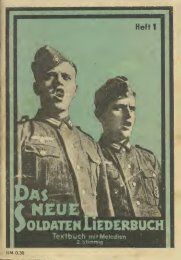Panzer-Lehr-Division SdKfz 251 markings December 15 ... - PALA 130
Panzer-Lehr-Division SdKfz 251 markings December 15 ... - PALA 130
Panzer-Lehr-Division SdKfz 251 markings December 15 ... - PALA 130
You also want an ePaper? Increase the reach of your titles
YUMPU automatically turns print PDFs into web optimized ePapers that Google loves.
A Hummel photographed on the banks of the Seine at Rouen.<br />
Given the relative rarity of these vehicles in Normandy, I decided to undertake an effort to do what I could to<br />
at least whittle down the field of candidate owners. With only one Battery of six Hummels per <strong>Panzer</strong> <strong>Division</strong><br />
(minus 21. <strong>Panzer</strong> and with the possible exception of (9. <strong>Panzer</strong> and 116. <strong>Panzer</strong>) plus replacements or other<br />
odds and ends (of which I could find no evidence), that means that only 54 Hummels served in Normandy<br />
and that is only if all batteries were at full strength upon arriving. Added to that would be 20 munitionsträger<br />
(2 per division except for 9. <strong>Panzer</strong> who had 4, though it is not know if all four were sent to Normandy).<br />
As with most other German AFVs, the Hummel went through several noticeable changes throughout its<br />
production life. Unlike other vehicles, though, the design changes were not granted any sort of official<br />
designation. When discussing the Hummel, therefore, one must resort to an informal terminology to describe<br />
the different production types. For a more detailed discussion of this refer to Nuts & Bolts. For my purposes, I<br />
will use the term "early" to describe Hummels with a driver only pod and a centrally-mounted muffler on the<br />
rear of the vehicle, the term "mid" for those Hummels that still have the driver only pod but which have<br />
exhaust pipes which no longer connect to the rear-mounted muffler (the muffler having been deleted) and<br />
the term "late" for those Hummels which have the driver and co-driver compartment. All of the "late"<br />
Hummels that were photographed in Normandy still lack the armored cover for the air intake louvers so at<br />
times I refer to these as "early late".<br />
Most Normandy Hummels appear to be the mid-type Hummel with the driver only pod (and simple hatch for<br />
co-driver), but with the rear-mounted muffler deleted. There are a few (three, possibly four, that I have seen<br />
and one munitionsträger) Hummels with the later version driver & co-driver compartment. Since 1.SS and<br />
116 <strong>Panzer</strong> and <strong>Panzer</strong> <strong>Lehr</strong> were equipped with Hummels immediately before or during the beginning of the<br />
Normandy invasion, it is probable that these three were issued the "Late" version. None of the late Hummels<br />
of which I have seen photos have armored covers for the air intakes (see the example under "Unidentified<br />
Hummels".<br />
Since Hummels were considered artillery pieces, the allocations of them were the responsibility of the Gen. d.<br />
Artillerie and not many records from that department survived, so exact allocations would require combing<br />
through <strong>Division</strong>al, Corps and Army records.<br />
Many sources categorically state that the I. Abteilung of each <strong>Panzer</strong>-Artillerie-Regiment was the self-



